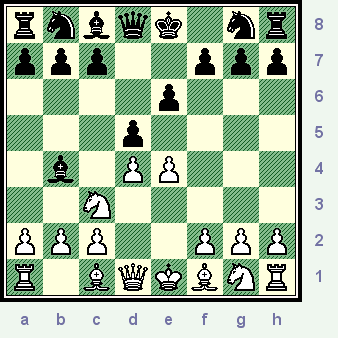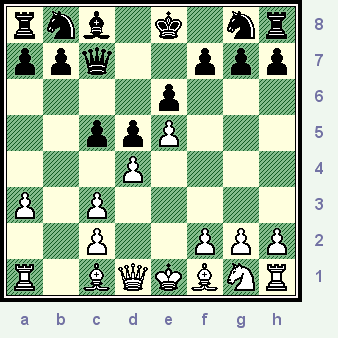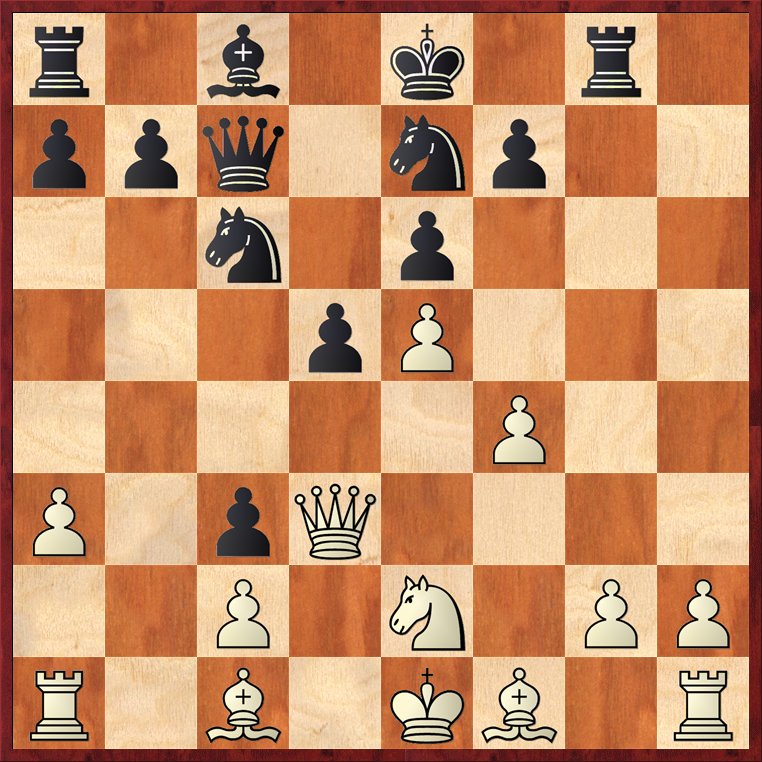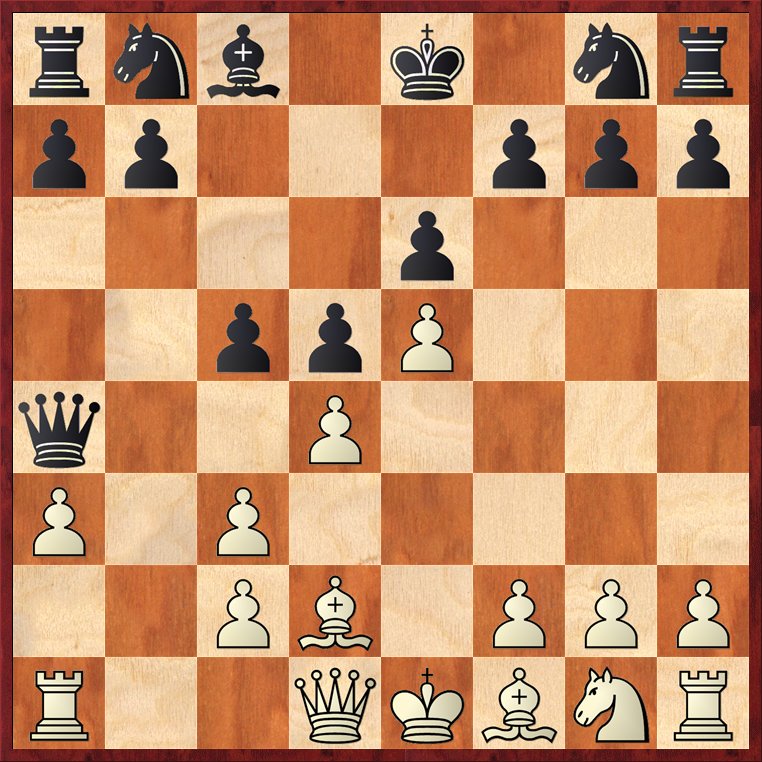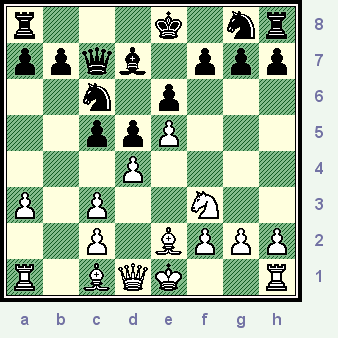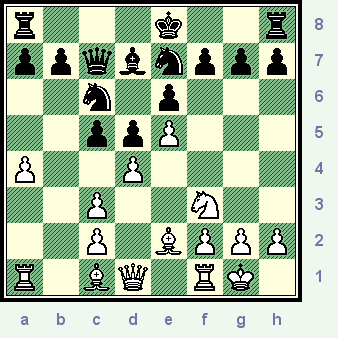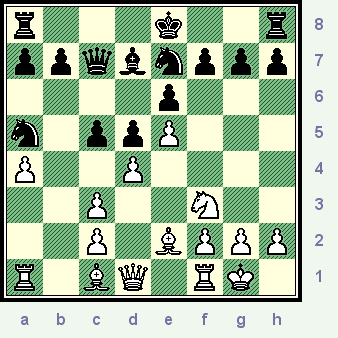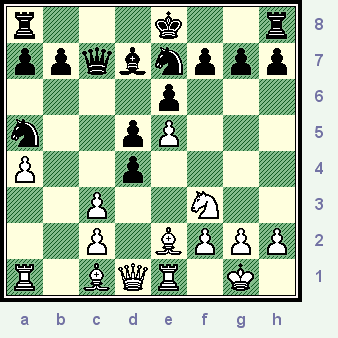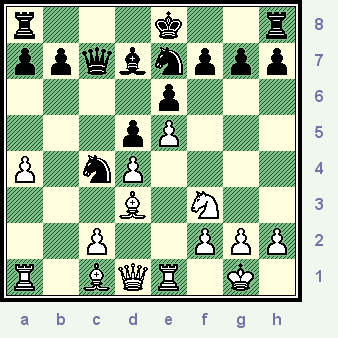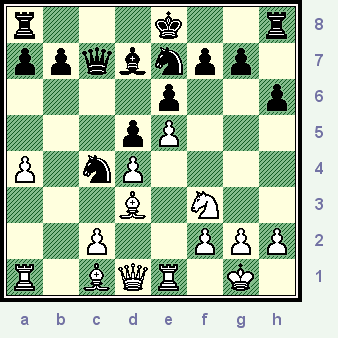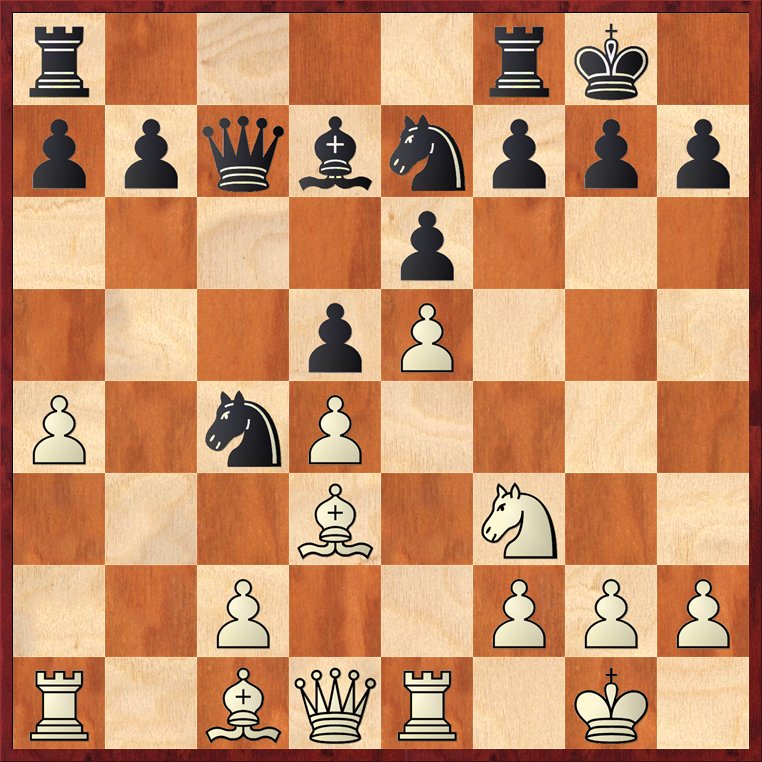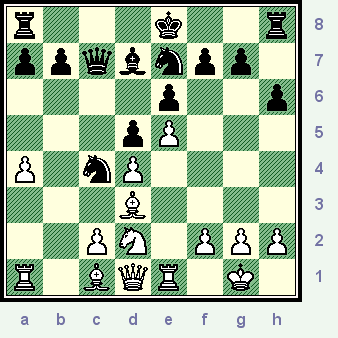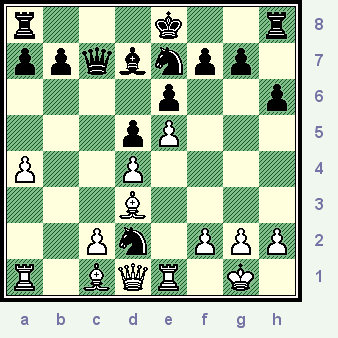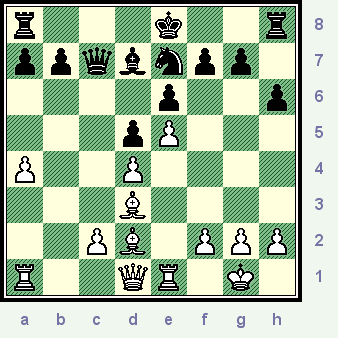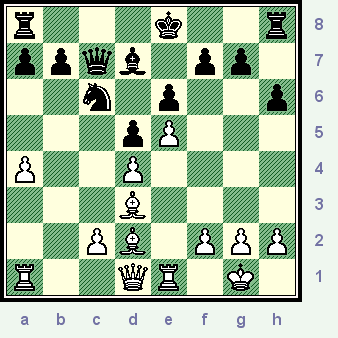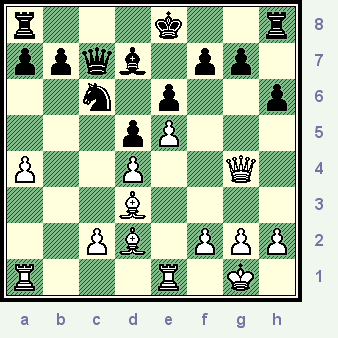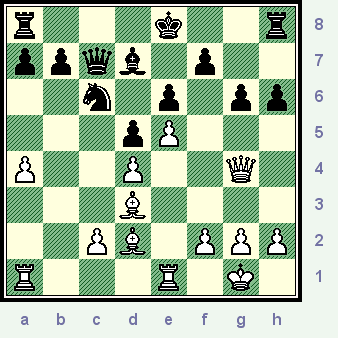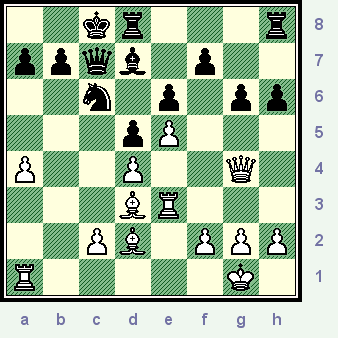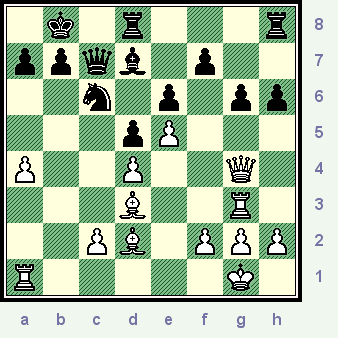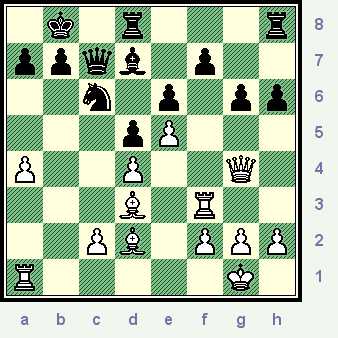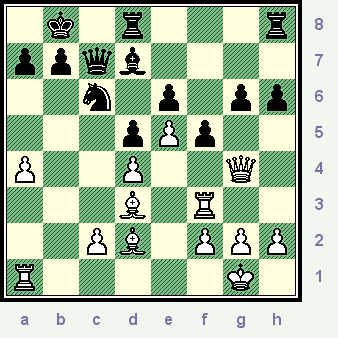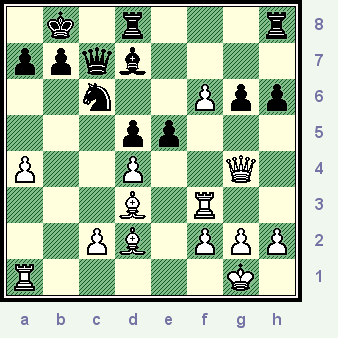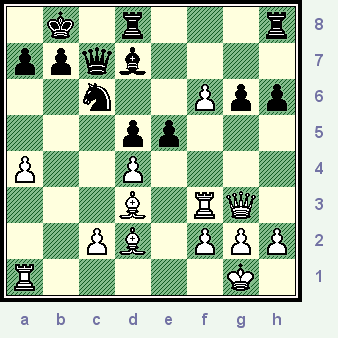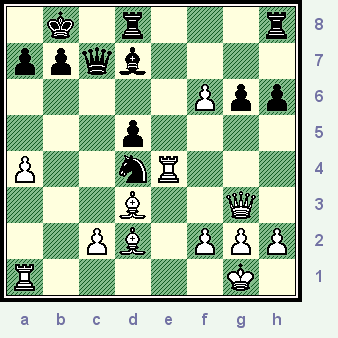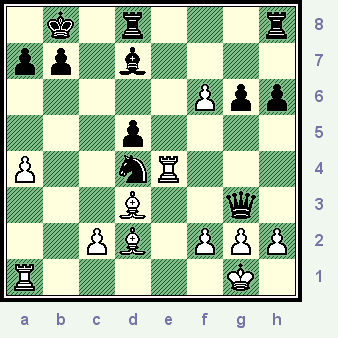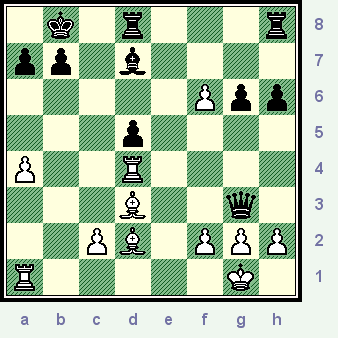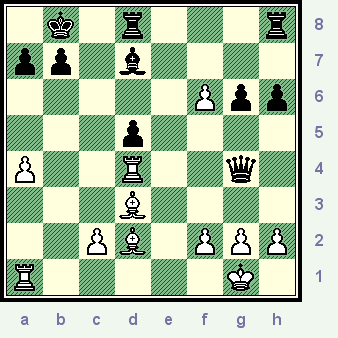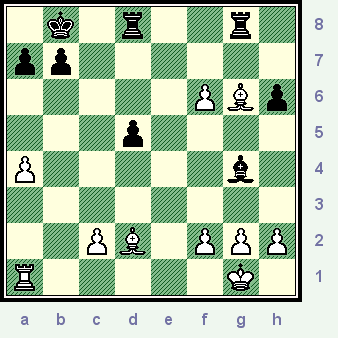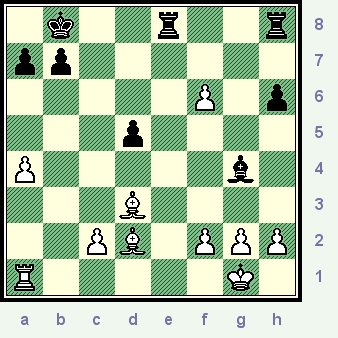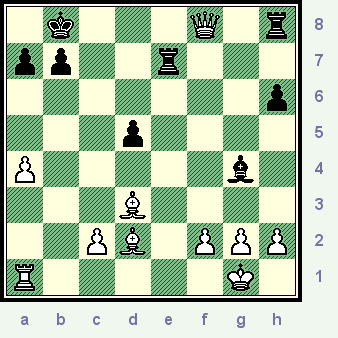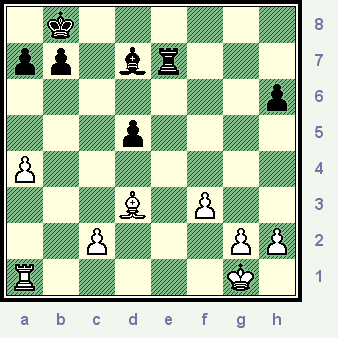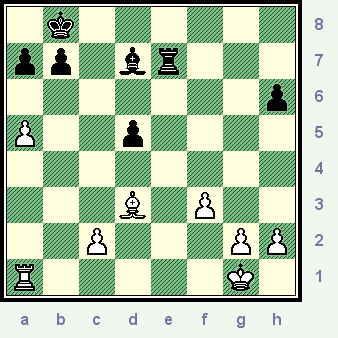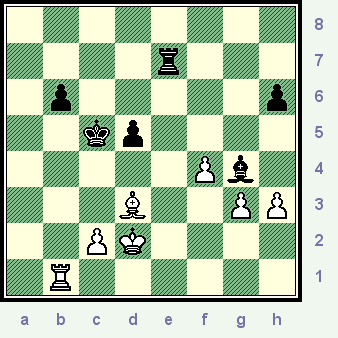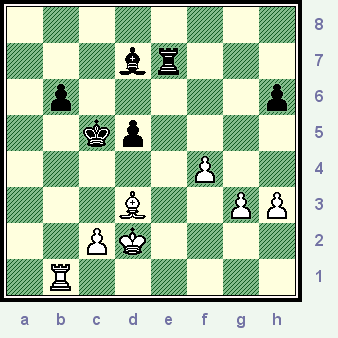All
the |
(Navigation bar
directly below.)
*******
© A.J. Goldsby, 2015.
(All rights reserved.)
****************
Click HERE
to see my
Chess Items.
****************
****************
Buy a book
from Amazon.com
(And help me out as well!)
****************
Click HERE
...
to see a list of the businesses that help to sponsor all of
my chess efforts.
Fischer - Schweber; 1970 |
|
(Feb.
2012) I got involved with this game many years ago, (around 1997 - I
found an unfinished CB file on one of my external hard drives) ... It was featured (several times) as either "The Problem of The Day" or "The Game of The Day" on the CG website. (As far as I can determine, it was featured as the POTD first back in September, 2004. (Read the comments in the "kibitzing" section ... just below the game.) Once again, last October 28th, it was "The Game of The Day." I began an analysis almost immediately, however, I was experiencing continuous computer problems ... that finally ended in a full-blown crash of my main hard drive in late December, 2011. (I also was caught up in several other projects at once ... this page was just one of the many items that I began working on around that time.) However, I saved most of my work - it has become a habit over the years, as I finish annotating a game to immediately save the file {as a CB archive} on an external hard drive. On Sunday, (Feb. 5th.); it was (again) featured as "The Problem of the Day." Of course, this (once more!!) reminded me of the work that I had begun on this epic and historic contest. This time, I decided that I wanted to finish the web page for this game, my analysis - that I began last October - was nearly complete, all that remained was to apply the finishing touches. (Worked for 2-3 days polishing the analysis and verbiage, and then I began doing the actual web page.) |
|
Click HERE to see an explanation of the symbols that I commonly use when I annotate any chess game. Click HERE
to replay this game ... on another server. Click HERE to see my video channel on the "You-Tube" channel. (Click HERE to see my video on this game.) |
Robert James ("Bobby") Fischer (2685) -
Samuel Schweber (2383);
|
|
|
[A.J. Goldsby I]
A famous game of chess, much has been said and written about this game ... Black's play has been described as "tough and solid" and White's {endgame} play has been described as "flawless" ... ... ...
BCM (British Chess Magazine) did a series of magazine articles on this tournament, as did other periodicals of that time. (The author of that particular article is one of my favorites. I do not mention his name here, simply because I do not want to be seen as holding him up for ridicule ... he also did not have computer engines to work with, as well.)
Many completely wrong things have
been written about this game ...
for more, please see the book: "The Games of
Robert J. Fischer," edited by Robert G. Wade and also
Kevin O'Connell.
(Dozens of contributors to this book, listed on the cover are: Leonard Barden, Arthur Bisguier, Les Blackstock,
Harry Golombek, and Paul Keres.)
Copyright (first edition) 1972, & reprinted many times. ISBN: # 0-7134-2099-5
This is game # 519, page # 272. (In the book - referenced just above - of Fischer's games.)
***********************************************************************************************************************************************************
This game was also annotated by GM Petar Trifunovic, see
Informant
# 10, game # 250.
***********************************************************************************************************************************************************
When you pull this up from the on-line (ChessBase) DB, it indicates that there
should be 47 moves, but only gives the first 29 moves. (Why?!?)
[The "Mega" Database gives the complete score ... I am not sure why (or how) the moves of this game got
truncated ... but this is NOT an isolated incident, I have noticed many examples of this when dealing with
the electronic (on-line) database ... which ChessBase touts as the most
accurate and complete in the world! ---> This is a major flaw, I think
that they need to fix this!]
***********************************************************************************************************************************************************
***********************************************************************************************************************************************************
***********************************************************************************************************************************************************
White begins with his much loved KP, Black counters with a French Defense.
1.e4 e6; 2.d4 d5; 3.Nc3 Bb4; (pin / a threat to create doubled-QBP's)
|
|
rnbqk1nr/ppp2ppp/4p3/3p4/1b1PP3/2N5/PPP2PPP/R1BQKBNR w KQkq - 0 4
The Winawer - an extremely complex variant of the French Defense that was really fashioned into a playable system by one of the leaders of the Hyper-modern revolution, (Aaron Nimzovich).
We now enter one of the main lines of this whole system.
4.e5 c5; 5.a3 Bxc3+; 6.bxc3 Qc7; (transpositional '!?')
At one time, Fischer may have believed that this move order (by Black) prevented the dangerous lines of the "French Poisoned Pawn."
At any rate, he was never a fan
of that line (for White) and I can find no examples of Fischer using the "Q/d1-g4xNP/g7," idea at all ...
not in any (games) database.
|
|
rnb1k1nr/ppq2ppp/4p3/2ppP3/3P4/P1P5/2P2PPP/R1BQKBNR w KQkq - 0 7
This is a good place for a diagram
(see just above) ... the Pawn chains here, especially White's doubled QBP on the Q-side ...
will have a big impact on the game. (For both sides.)
[ For the lines that employ the following moves:
6...Ne7;
(This is usually considered to be
the main line by opening theory.)
7.Qg4 Qc7;
8.Qxg7 Rg8;
This system is sometimes known
as "The French Poisoned Pawn."
9.Qxh7
cxd4; 10.Ne2 Nbc6; 11.f4 dxc3; 12.Qd3,
"+/=" (unclear?) [Black
has good play for the Pawn.]
please see MCO-15, pg. # 217.
(Columns # 31- 33; and all notes.)
|
|
r1b1k1r1/ppq1np2/2n1p3/3pP3/5P2/P1pQ4/2P1N1PP/R1B1KB1R b KQq - 0 12
A good - relatively recent example - of the use of this variant is:
GM Sergey
Karjakin (2721) -
GM Gata Kamsky (2720);
[C18]
The FIDE Grand Prix (R#07)
/ Nalchik, RUS / 2009 (1-0)
{White won a nice
game,
in a total of 32 moves.}
**************************************************************************************************
Super GM Lajos Portisch ... in the landmark
book, "How To Open A
Chess Game," [See
this book - on Amazon-dot-com.]
(page # 97) recommended that
Black play the odd continuation of:
6...Qa5!?;
7.Bd2, "+/=" 7...Qa4!?;
when Black will often go to great
lengths to blockade the Q-side.
|
|
rnb1k1nr/pp3ppp/4p3/2ppP3/q2P4/P1P5/2PB1PPP/R2QKBNR w KQkq - 0 8
I have not seen many GM examples of this whole {fairly rare} sub-system, one example -
that I culled from the database -
would be the following game:
GM Vassily
Ivanchuk (2787) -
GM Bartosz Socko (2646);
[C18]
The 16h
European (men's) Team
Championships (CH) / Heraklion, Greece; (R #8.1) / 2007.
(White won
a tough
struggle,
1-0 in 63 total moves.) ]
As far as I can tell, Bobby Fischer always eschewed the ultra-sharp lines with Qg4, and generally was known to prefer the variants that featured a positional treatment of The Winawer Variation. (Nf3/a4)
[ For more info on the continuations where White does NOT play Qg4, please see MCO-15, beginning on page # 220, columns # 37 - 42.]
7.Nf3 Nc6; 8.Be2 Bd7!?; ('?!')
Better was 8...Nge7; or even the strange-looking 8...f6. (In some lines of the Winawer, Black may play his Bishop to a6.)
|
|
r3k1nr/ppqb1ppp/2n1p3/2ppP3/3P4/P1P2N2/2P1BPPP/R1BQK2R w KQkq - 0 9
Korchnoi virtually pioneered an early ...f7-f6!? in the French, this may be one of those times when Black should consider this as a playable option.
[ Better was: >/= 8...f6!; - Fritz 12.
(also) Better was: >/=
8...Nge7!?;
- Theory. (And several authors.)
]
9.0-0 Nge7; 10.a4!, (Queen-side expansion.)
This is undoubtedly best, it is a common White strategy to gain space on the Q-side in many of the variations of the Winawer System.
|
|
r3k2r/ppqbnppp/2n1p3/2ppP3/P2P4/2P2N2/2P1BPPP/R1BQ1RK1 b kq - 0 10
If you are not familiar with the theory of the Winawer, then a somewhat subtle idea like a3-a4 might not occur to you. (IMO)
[ One of my students came up with the idea of going for f4-f5,
but this does NOT work out
well for White!
For example: </=
10.Kh1? 0-0; 11.Nh4?! Qa5!;
"="
and - in this variation - White
has blown a fairly large edge. ]
10...Na5!?; (Possibly - '?!')
GM P. Trifunovic (In the volume, Informant #10/gm 250.); gives this a dubious appellation, ('?!') and instead recommends that Black play 10...b6!
|
|
r3k2r/ppqbnppp/4p3/n1ppP3/P2P4/2P2N2/2P1BPPP/R1BQ1RK1 w kq - 0 11
The move of 10...b6; does not {in the final analysis} change the engine's overall assessments of Black's position in a major fashion, so I do not think that it really matters that much. (The idea of ...Na5; is at least correct in principle, Black is trying to get his Knight to a strong outpost on the c4-square.)
11.Re1 cxd4?; (A critical change ... affecting the Pawn-structure.)
This
"un-doubling" of the Pawns is
a standard Black error in these types of Winawer positions.
(Note that - because of this bad exchange by Black - White's LSB goes to d3 ... and then just stays
there.
This vastly changes the nature of the whole game!)
|
|
r3k2r/ppqbnppp/4p3/n2pP3/P2p4/2P2N2/2P1BPPP/R1BQR1K1 w kq - 0 12
Strangely - the engines grasp this
almost right away ... but a GM (Trifunovic) did not seem to question this move at all ...
at least, he said nothing at all in his annotations of this historic encounter.
[ The correct continuation was: >/= 11...h6; ('!') 12.Ba3 b6; 13.Qd2, "+/=" - Fritz 12. ]
(Some chess engines prefer the move of: 12...Nf5; for Black; as compared to what was played here - in the actual game.)
12.cxd4 Nc4; 13.Bd3!,
GM P. Trifunovic gives this move
an exclam here. And since there were at least 3-4 playable alternatives here ...
I will go ahead and back him up. (13.Bd3, is also the first choice of Fritz 12 here as well.)
|
|
r3k2r/ppqbnppp/4p3/3pP3/P1nP4/3B1N2/2P2PPP/R1BQR1K1 b kq - 0 13
A good place for a diagram ... study this position for a few minutes ... and try to decide what you would play ... (for either side).
[ Also good was: RR 13.c3, "+/=" (with a small, stable edge for White). ]
13...h6!?; (Hmmm.)
This looks like it weakens Black's King-side a little ... and it does.
|
|
r3k2r/ppqbnpp1/4p2p/3pP3/P1nP4/3B1N2/2P2PPP/R1BQR1K1 w kq - 0 14
However, some of the alternatives
{for Black} were even worse.
[GM P. Trifunovic points out that if Black (instead) castles K-side here, he gets immediately
slammed by the "Greek Gift"
Bishop-sack on h7.
See my analysis
- on my page
dedicated to this tactical theme - for more details.]
[ Black runs into problems ... if he castles here:
If </= 13...0-0!?; ('?!'
... Maybe - '?') (See the diagram - just below.)
This is what is known as ...
"blindly following principles."
********************************
|
|
********************************
Now White plays the rather simple 14.BxP/h7+!, and will win the game rather routinely.
Click HERE to see my detailed analysis of this variation. ]
14.Nd2!, (Why?)
White immediately rids himself of
Black's strong Knight on c4.Since GM P. Trifunovic awards this move an exclam here,
I will do so as well.
(White had many playable ideas here.)
|
|
r3k2r/ppqbnpp1/4p2p/3pP3/P1nP4/3B4/2PN1PPP/R1BQR1K1 b kq - 0 14
White had several (other)
viable concepts here, but I am certain that 14.N-Q2! was the most accurate.
(And the engines confirm this.)
[ Less accurate would have been the following continuation:
</=
14.c3!?, "+/="
14...Qa5!;
"<=>" (counterplay)
Black has some play and White only has a minimal advantage in this position.
]
14...Nxd2?!; ('?') {Inferior/bad.}
Black would have been better off doing almost anything else ...
he should have let White capture on c4, then Black could recapture with the Pawn. Then Schweber would have gotten the d5-square for his Knight and also opened the long diagonal for his LSB. (After this move by Black the computer shows a downturn of nearly half a point.)
|
|
r3k2r/ppqbnpp1/4p2p/3pP3/P2P4/3B4/2Pn1PPP/R1BQR1K1 w kq - 0 15
This move also violates chess logic, there are several games in the books on the French Defense that clearly illustrate this idea.
[ Almost certainly the following continuation represents a distinct improvement over the course of the actual game:
>/=
14...0-0; 15.Bxc4, "+/="
('±')
< White is clearly better. >
(The
above "grading" of the analysis position is based on the evaluations of:) - Fritz 12.
]
15.Bxd2, "+/=" (Space, development.)
The engines already show a very large edge for White here.
(+ 1.17 - and this was after letting Fritz "chew" on this position for many hours.)
|
|
r3k2r/ppqbnpp1/4p2p/3pP3/P2P4/3B4/2PB1PPP/R2QR1K1 b kq - 0 15
The only question here ... is how should Black proceed?
15...Nc6?; (bad; red-light)
A big-time error, according to
Fritz ... and several other engines.
(Black should have simply castled.)
|
|
r3k2r/ppqb1pp1/2n1p2p/3pP3/P2P4/3B4/2PB1PPP/R2QR1K1 w kq - 0 16
One of the main reasons that this move is wrong is that it allows his opponent to play his next move ...
and virtually assure that Black will not ever be able to castle K-side.
[ Black should have
(instead) played: >/=
15...0-0[];
16.Qf3,
"+/=" ('±')
- Fritz 12.
[The moves of: 16.Bb4, and also just the simple 16.c3, (and possibly
even 16.Qg4!?);
are all good for White.] ]
White's next move is energetic ... and permanently discourages his opponent from trying to castle on that side of the board.
(There are many alternatives, but none measure up to Fischer's move.)
16.Qg4!, (threats + piece activity)
|
|
r3k2r/ppqb1pp1/2n1p2p/3pP3/P2P2Q1/3B4/2PB1PPP/R3R1K1 b kq - 0 16
Now if Black should castle, simply BxP/h6 wins for White.
[ Less energetic was: </= 16.c3!?, "+/=" although White retains a small edge here. ]
16...g6T; (box/forced)
Black pretty much has to play this. (Fritz.) Instead of 16...g6; Houdini has Black castling on the Q-side, which gives away several Pawns ...
Black is soon totally lost.
|
|
r3k2r/ppqb1p2/2n1p1pp/3pP3/P2P2Q1/3B4/2PB1PPP/R3R1K1 w kq - 0 17
This position is very bad for Black, Fritz is already showing an "eval" of "+-" (+1.99); however, this is a tad over-optimistic, in my opinion.
***********************************************************************************************************************************************
Now about a dozen very good engines all prefer 17.Reb1.
(The author of the article in BCM gives White's 17th move an exclam here, but {IMO} that would be completely unjustified. In fact, White's 17th move
could be inferior. However, since I cannot prove that beyond a shadow of a doubt, I decided to remain neutral about the move.)
I think that it is noteworthy that GM Trifunovic did NOT single out Re3 for any praise when he did annotate this game for the well-respected 'Informant' series.
17.Re3!? 0-0-0?!; (Maybe - '?')
This is the current position, although (according to the computers) - Black probably should not have castled on the Queen-side here.
|
|
2kr3r/ppqb1p2/2n1p1pp/3pP3/P2P2Q1/3BR3/2PB1PPP/R5K1 w - - 0 18
Black's last move ... (of castling on the Q-side); was NOT the best, and now Fritz 12 already considers Black to be lost. (Instead of the line played in the actual game, the computer {now} finds a nice Queen maneuver ...one that would have given Black some decent play ... see the note below.)
[ Fritz 12,
Deep Junior, and Houdini 1.5 all find the move
of: >/= 17...Qb6!;
"<=>" (counterplay)
with the idea of playing ....Qb2; next. (This is a fairly big improvement over the course of the actual game, here.)
]
*************************************************************************************************************************************
Fischer's next move may not be the best ... (Better was >/=
18.Rf3! - GM Petar Trifunovic.)
[ ... in fact, Fischer's move loses quite a bit of value, at least this is true in the estimation of several different computer programs. Other than maybe a cheap trap, and after days of study, I can see no real point to Fischer's R/e3-g3 move at all. (I was tempted to assign the "inferior" grading, but this
might have been seen as being too dependent on the computers or
as appearing to be overly harsh.) ]
Fritz 12 prefers: >/= 18.a4-a5! '±' ---> Houdini 1.5 likes: >/= 18.Rb1. '±' (In both cases, White is clearly better. "+/")
18.Rg3!? Kb8; (King-safety.)
GM P. Trifunovic awards this rather logical-looking move a question-mark here, but does not tell us what Black should have played instead.
[Some programs even choose the move 18...Kb8 for Black! Initially, I was going to award it the "inferior" grade, but after much thought, I decided that this may not be fair to Black, the second player's position is already difficult, yet this was due to his many
(earlier) inaccurate moves, & not this idea.]
|
|
1k1r3r/ppqb1p2/2n1p1pp/3pP3/P2P2Q1/3B2R1/2PB1PPP/R5K1 w - - 0 19
There is not really much of a tangible
difference in most of the engines' appraisals/evaluations of these two moves,
---> (18...Kb8; or 18...g5!);
so
I would think that the nod would go to the more logical move here.
[ Instead of what was actually played in the game, the metal monster prefers the move of:
(</=)
RR
18...h5!?;
(Dubious?)
but to me, this just seems to
weaken the dark-squares even more than the text-move.
(Now Fritz 12 gives 19.Qf4, "+/-")
]
19.Rf3!?, ('?!')
{An error?}
Despite all the praise heaped on this move, (see BCM); its possible that this move
was not the best, and that it was even an inferior move.
|
|
1k1r3r/ppqb1p2/2n1p1pp/3pP3/P2P2Q1/3B1R2/2PB1PPP/R5K1 b - - 0 19
<< "19.Rf3!" - GM P. Trifunovic >>
(See Informant #10, game # 250. The author of the BCM article also praised this move.)
[ I like the machine's idea; best was: >/= 19.a5!, '±' ("+/") - Fritz 12. ('+-' / +1.78) ]
Now we enter the tactical phase of this intriguing game.
19...f5!; "<=>" (space, counterplay)
When I first went over the game, (without an engine); I had pin-pointed this as Black's losing move - alas (here) I was not on target here, not at all.
|
|
1k1r3r/ppqb4/2n1p1pp/3pPp2/P2P2Q1/3B1R2/2PB1PPP/R5K1 w - f6 0 20
19...f5; is the first choice of Fritz 12; as well as several other chess engines; I would describe his move as a computer-supported gamble ... ... ...
or possibly even a desperate bid for freedom - by Schweber.
<< "19...f5?" - GM P. Trifunovic >>
(He suggests the constipated 19...Be8; but this move - according to the all the chess engines - leaves Black in even worse shape than 19...f5.)
*** *** *** *** *** *** *** *** *** *** *** *** *** *** *** *** *** *** *** *** *** *** *** *** *** *** *** *** *** *** *** *** *** *** *** ***
Naturally, White (having the two Bishops) would want to open the position as much as possible.
20.exf6 e5?!; (Maybe just - '?')
This was a REALLY!!! bad idea ... the obvious should not have
to be stated.
(That opening the b8-h2 diagonal is the underlying cause of nearly all of Black's future problems in this game.)
|
|
1k1r3r/ppqb4/2n2Ppp/3pp3/P2P2Q1/3B1R2/2PB1PPP/R5K1 w - - 0 21
NO ONE ... as far as I can tell ... has questioned this move, (20...e5); at all ...
[ Better was: >/=
20...g5!;
"<=>" (counterplay) when Black gets good play to compensate
for the loss of one pawn. (Its
even possible that Black can get the Pawn on f6 back ... in around
3-5 moves from this position, so that capturing
it immediately was not necessarily forced.) ]
Now White's next move is the one that should be praised ... its the beginning of a fairly long tactical sequence ...
and all the engines confirm it as being best.
21.Qg3!!,
(Best - Fritz 12.)
This was the tough move to find.
(And you have to be a magical player to really see all the really wonderful things that will happen afterwards.)
|
|
1k1r3r/ppqb4/2n2Ppp/3pp3/P2P4/3B1RQ1/2PB1PPP/R5K1 b - - 0 21
White could have captured on g6 ... for a smaller
(but safe) advantage, instead Fischer plays a seemingly inane move ...
that sets a fairly deep tactical trap here.
[ Interesting was: RR 21.Qxg6!?, "+/=" ]
Fritz (and several other engines) show the next series of moves; (Through White's 24th move); to be absolutely best/forced.
21...Nxd4; 22.Re3!, (best)
Wade and O'Connell give this move an exclam, I will follow suit, due to the variation that I found - just below.
(White could have set a trap here, but it is one that is fairly easy to refute.)
[ RR 22.Rf4!? g5!; (</= 22...exf4??; 23.Bxf4, "+/-") 23.Rxd4!, "+/=" - Fritz 12. ]
22...e4; 23.Rxe4!, (Definitely best.)
Wade and O'Connoll also give this move an exclam ... and it is, because White had at least one fairly reasonable alternative here.
("23.Rxe4!" - BCM & Trifunovic.)
|
|
1k1r3r/ppqb4/5Ppp/3p4/P2nR3/3B2Q1/2PB1PPP/R5K1 b - - 0 23
This move also deserves an exclam
for purely psychological reasons ...
normally you do not take a Pawn with your Rook when you know that another Pawn may simply
recapture the flagrant offender.
[ White could have played the plausible (but inferior) series of moves:
</=
23.Bf1 Qxg3; 24.Rxg3 g5;
"~" (unclear)
White might have a tiny edge, but machine analysis shows that Black
has no real problems from this position.
]
23...Qxg3T; ("[]" Best/forced.)
The engines all agree that Black must play this move, otherwise White has snipped a free button, (when he took on e4); and Black will have gotten nothing for his lost Pawn.
|
|
1k1r3r/pp1b4/5Ppp/3p4/P2nR3/3B2q1/2PB1PPP/R5K1 w - - 0 24
One might expect a routine re-capture of the Black Queen here, and this is certainly what would happen in 99% of most chess games ... ... ...
[ </= 23...Ne6?; 24.Re5, "+/-" (or) </= 23...Nc6??; 24.Bf4, "+/-" ]
24.Rxd4!, (Forced!?)
This is Fischer's witty little
trap here ... ... ...
this move is discovered quite easily by the machines ... however, it is much tougher
for a human to find.
(Counterpoint: "Fischer had to find this move - or resign.")
|
|
1k1r3r/pp1b4/5Ppp/3p4/P2R4/3B2q1/2PB1PPP/R5K1 b - - 0 24
Once more - Wade and O'Connoll also award this move an exclam, but without this move, White would now have a lost game!
[ << Now (the) INFORMANT gives:
"24.Rxd4!!" - GM Petar Trifunovic. >> ]
[ Of course not: </= 24.hxg3?? dxe4; "-/+" and Black now has a very easy win here. ]
24...Qg4?!; (Maybe - '?')
Black (predictably) goes for gaining some material, however, all the engines show that this was also bad ... ... ... very bad.
(White's two powerful Bishops and monster of a passed f-pawn make Black's Rooks look silly.)
|
|
1k1r3r/pp1b4/5Ppp/3p4/P2R2q1/3B4/2PB1PPP/R5K1 w - - 0 25
Instead, Black could have been down only a Pawn, had two Rooks and a Bishop ... and a position that is not so easily won, see the two lines ... just below. (In both of the lines that I give - there is the quite real possibility that Black will simply regain the Pawn - making Fischer's win problematic.)
[ Either of the two possibilities below probably represent a fair improvement over the course of the actual game.
>/= 24...Qc7; 25.Bf4 Rdf8; 26.Bxc7+ Kxc7; 27.Bxg6 Rxf6; 28.Bd3, '±' ("+/") - Fritz 12.
*************************************************************************************************
>/= 24...Qd6; 25.Bf4 Be8; 26.Re1 Rf8; 27.Re6 Qxf4; 28.Rxf4 g5; 29.Rd4 Bf7; 30.Re5 Rd6; 31.f4, '±' ("+/") - Houdini 1.5 ]
25.Rxg4 Bxg4; 26.Bxg6 Rhg8!?;
Maybe it was better to place this Rook (immediately) on f8.
|
|
1k1r2r1/pp6/5PBp/3p4/P5b1/8/2PB1PPP/R5K1 w - - 0 27
According to all the engines, (Fritz 12, Rybka 3, Houdini 1.5, Deep Junior, Crafty, Shredder, etc.); White is winning the endgame here ...
but its NOT by a very big margin, or anything even close to that!
27.Bh7 Rh8; 28.Bd3 Rde8;
Black is hanging on ...
|
|
1k2r2r/pp6/5P1p/3p4/P5b1/3B4/2PB1PPP/R5K1 w - - 0 29
... if by only a thread here.
**************************************************************************************************
All the chess engines indicate that >/= 29.Bb4! was probably the best move in this position for White.
29.f7 Re7; 30.f8Q+, ('!?')
Fischer just promoted his Pawn, and many (most?) annotators award this move an exclam here.
|
|
1k3Q1r/pp2r3/7p/3p4/P5b1/3B4/2PB1PPP/R5K1 b - - 0 30
Both BCM and the Informant praise this move ... and award it an exclam here. However, any good chess engine will show you that f3 or even h3 are probably better than the text. (Also, ---> 30.Bg6, will probably turn out to be a little better than what was played in the actual game.)
[ The refinement of: >/= 30.f3!, '±' ("+/") is slightly better than the text. (Houdini 2.0 ... on a friend's new DELL laptop.) ]
30...Rxf8; 31.Bb4 Rff7; 32.Bxe7 Rxe7; 33.f3 Bd7;
Take note of this position:
|
|
1k6/pp1br3/7p/3p4/P7/3B1P2/2P3PP/R5K1 w - - 0 34
An endgame has now been reached, but since Bobby Fischer was one of the best "chess technicians" that ever lived, we can be reasonably assured that White will be able to win this game.
White to move here, what is the very best move here for White?
34.a5!, < '!' - GM Petar Trifunovic >
|
|
1k6/pp1br3/7p/P2p4/8/3B1P2/2P3PP/R5K1 b - - 0 34
This is a subtle move ... Fritz does find it, but not right away.
(Most of the programs/engines that I tested - at least initially - look at 34.Kf2, here.)
Now the principles of play (that
govern the endgame) come into play, and are readily seen in the moves of both players.
(The next series of moves does not require a lot of comment here.)
34...Kc7;
35.Kf2 Rf7; 36.Ke3 Kd6; 37.g3 Kc5; 38.f4
Bg4; 39.Rb1 Re7+;
40.Kd2
b6; 41.axb6 axb6; 42.h3!, (Simplifying / a la' Capa!)
Once more Trifunovic awards this
an exclam, but the engines show that this might not have even been the very best move for
White ...
(Shredder finds the interesting maneuver of Ra1!?, followed by Re1.)
|
|
8/4r3/1p5p/2kp4/5Pb1/3B2PP/2PK4/1R6 b - - 0 42
Just above is our current position.
[ Absolutely, the best line for White would have been the following continuation ...
which quickly
reduces Black to a state of being unable to find a decent move (near/total zugzwang).
>/=
42.f5!! Rf7; 43.Rf1! Bh3!?;
This just seems to help White
accomplish his goals, however, Black did not have a lot of decent moves here.
(Or RR 43...Kd6; 44.Kc3, "+/-")
44.Rf4
Rf6; 45.Ke3 Bg2; 46.g4! Kd6!?;
Other moves also lose
badly for Black ...
47.Kd4
Bh3; 48.Bf1 Bxf1; 49.Rxf1 Rf8; 50.Re1!
Rf6; 51.Re5, "+/-"
(decisive)
White wins another Pawn,
both Fritz and Houdini show this to be a VERY easy
game for the first player here.
]
42...Bd7!?; (Best?)
Black decides not to capture, as
White would get two connected, passed Pawns on the King-side ...
see the variation given below.
|
|
8/3br3/1p5p/2kp4/5P2/3B2PP/2PK4/1R6 w - - 0 43
[
Instead, after the moves:
</=
42...Bxh3?!; 43.Rh1 Bc8;
44.Rxh6, "+/-"
(now) White's plan is simple ...
shove those passed Pawns! ]
43.g4 d4; 44.f5 Re3; 45.f6 Rf3; 46.Rf1 Rxf1; 47.Bxf1, "+/-" 47...Be6; & Black resigns.
|
|
8/8/1p2bP1p/2k5/3p2P1/7P/2PK4/5B2 w - - 0 48
Black quit because he probably
realized that White can simply play h4 and then g5, followed by Bd3.
(Black cannot take on g4, as this would allow White's f-Pawn to
advance all the way to f8.)
A marvelous game by Fischer -
as usual!!! - although many of the annotators did a sloppy job trying to pinpoint what Black's real errors
actually were.
[Of course, to be fair, I should point out that this game was
played (and analyzed) long before chess engines or PC's were ever used ...
or even invented!]
Copyright (c) A.J. Goldsby, 2011. All rights reserved.
Copyright (c) A.J. Goldsby, 2012. All rights reserved.
1 - 0
(BIBLIOGRAPHY)
See the opening paragraph for the two books that I referenced the
most.
(The book of Bobby Fischer's game and one issue of
the Informant.)
I
have probably close to 20 books on the French Defense, and I referenced
all of these in preparing this web page.
(I don't feel the need to name all of them
here.)
My
favorite book
- on the Winawer - is "The French Defense: Main Line, Winawer,"
by John Moles.
(It might seem dated, however, I don't believe
any subsequent authors have done a better job of laying out all the
pertinent variations and also explaining many of the basic ideas of this
very complicated line. McDonald did a book on this line, and do did
Moskalenko. Neither works surpass Moles's excellent treatise on the French
... however, that is just one man's opinion.)
I also accessed ECO, MCO-15 ... and many other reference works as well.
The analysis for this page was prepared with the excellent program, ChessBase 10.0. (I also used MANY chess engines!)
The HTML was polished with several different tools and programs, (mostly FP) ... the text was checked for spelling with MS Word.
The diagrams were created with the program, Chess Captor 2.25.
|
Go ... or return ... to my Home Page for this site. Go (or return) ... to my "Annotated Games" (II) Page. Go
... or return ... to my "Best Games" Page. *******
Copyright (c)
LM A.J. Goldsby
I ******* This page was first generated in: October, 2011. (Posted: (early) February, 2012.) Final format completed on: Friday; February 10th, 2012. This game was last edited, altered or saved on: July 22, 2013 12:28 AM . |
